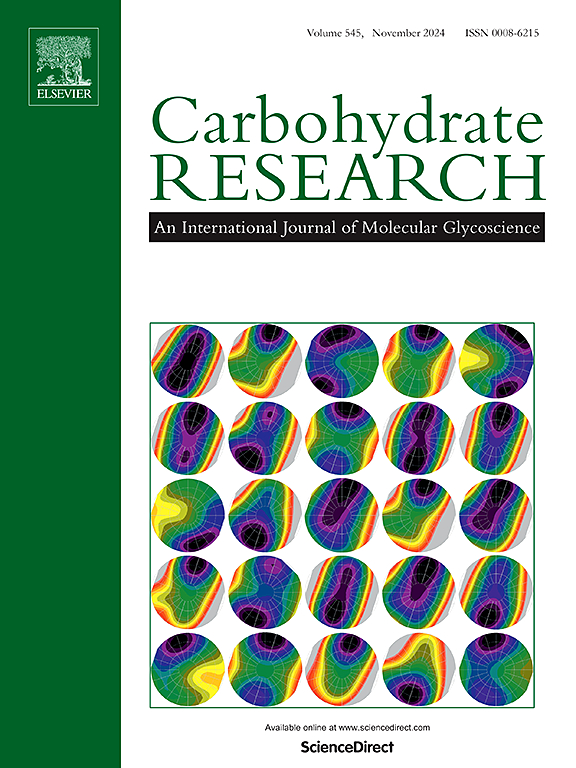Synthesis and antioxidant evaluation of coumarin-functionalised chitosan: A potent, non-toxic free radical scavenging compound
IF 2.4
3区 化学
Q3 BIOCHEMISTRY & MOLECULAR BIOLOGY
引用次数: 0
Abstract
In the present study, we designed to link the coumarin molecule to chitosan via a triazole group and synthesized chitosan-coumarin derivatives, which were further quaternized in one step in order to further improve their solubility to obtain a second series of chitosan-coumarin ammonium salt derivatives. The structures of these chitosan derivatives were verified by FT-IR and 1H NMR. They were tested for their antioxidant activities. The experimental results showed that the derivatives had excellent free radical scavenging ability. The introduction of the coumarin moiety significantly improved the antioxidant activity, and the scavenging capacity was much higher than that of the chitosan feedstock in all three antioxidant tests. Overall, the scavenging capacity of chitosan-coumarin ammonium salt derivatives was slightly higher than that of chitosan-coumarin derivatives, with the highest scavenging rates in all three tests. Compound 8B scavenged 98.74 % (0.01 mg/mL) of superoxide anion radicals, compound 8D scavenged 95.5 % (0.3 mg/mL) of DPPH radicals and compound 8A scavenged 92.97 % (0.2 mg/mL) of hydroxyl radicals. Toxicity assays used L929 cells demonstrated that there was no significant toxicity of the derivatives. The results indicated that the chitosan derivatives described herein were safe and non-toxic and have good antioxidant activity.

香豆素功能化壳聚糖的合成和抗氧化评价:一种有效的、无毒的自由基清除化合物。
在本研究中,我们设计通过三唑基团将香豆素分子与壳聚糖连接,合成了壳聚糖-香豆素衍生物,并将其一步季铵化,进一步提高其溶解度,得到了第二系列壳聚糖-香豆素铵盐衍生物。这些壳聚糖衍生物的结构通过FT-IR和1H NMR进行了验证。测试了它们的抗氧化活性。实验结果表明,该衍生物具有良好的自由基清除能力。香豆素片段的引入显著提高了其抗氧化活性,在三种抗氧化试验中,其清除能力均远高于壳聚糖原料。总体而言,壳聚糖-香豆素铵盐衍生物的清除率略高于壳聚糖-香豆素衍生物,在三种试验中清除率均最高。化合物8B清除98.74% (0.01 mg/mL)的超氧阴离子自由基,化合物8D清除95.5% (0.3 mg/mL)的DPPH自由基,化合物8A清除92.97% (0.2 mg/mL)的羟基自由基。用L929细胞进行毒性试验,结果表明该衍生物无明显毒性。结果表明,制备的壳聚糖衍生物安全无毒,具有良好的抗氧化活性。
本文章由计算机程序翻译,如有差异,请以英文原文为准。
求助全文
约1分钟内获得全文
求助全文
来源期刊

Carbohydrate Research
化学-生化与分子生物学
CiteScore
5.00
自引率
3.20%
发文量
183
审稿时长
3.6 weeks
期刊介绍:
Carbohydrate Research publishes reports of original research in the following areas of carbohydrate science: action of enzymes, analytical chemistry, biochemistry (biosynthesis, degradation, structural and functional biochemistry, conformation, molecular recognition, enzyme mechanisms, carbohydrate-processing enzymes, including glycosidases and glycosyltransferases), chemical synthesis, isolation of natural products, physicochemical studies, reactions and their mechanisms, the study of structures and stereochemistry, and technological aspects.
Papers on polysaccharides should have a "molecular" component; that is a paper on new or modified polysaccharides should include structural information and characterization in addition to the usual studies of rheological properties and the like. A paper on a new, naturally occurring polysaccharide should include structural information, defining monosaccharide components and linkage sequence.
Papers devoted wholly or partly to X-ray crystallographic studies, or to computational aspects (molecular mechanics or molecular orbital calculations, simulations via molecular dynamics), will be considered if they meet certain criteria. For computational papers the requirements are that the methods used be specified in sufficient detail to permit replication of the results, and that the conclusions be shown to have relevance to experimental observations - the authors'' own data or data from the literature. Specific directions for the presentation of X-ray data are given below under Results and "discussion".
 求助内容:
求助内容: 应助结果提醒方式:
应助结果提醒方式:


